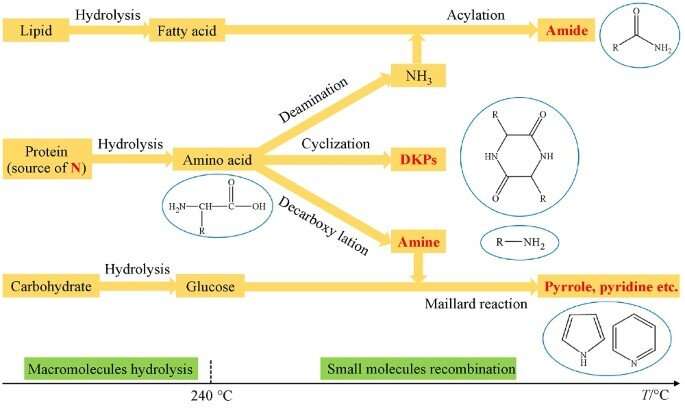Credit: Bao et al, Frontiers of Chemical Science and Engineering (2022). DOI: 10.1007/s11705-021-2126-y
The high content of nitrogen-containing organic compounds (NOCs) in biocrude obtained from hydrothermal liquefaction of microalgae is one of the most concerning issues on the applications and environment. The biocrude obtained by hydrothermal liquefaction (HTL) needs further refining optimization, and the high concentration of nitrogen-heterocyclic compounds such as quinoline, pyridine, etc., will poison the catalyst used in the refining process, so that the deactivation of the catalyst will cause great difficulties in refining the biocrude. Moreover, NOCs and sulfides have a competitive relationship in the desulfurization process of biocrude, which inhibits the desulfurization effect. Although there have been many studies on tackling nitrogen-related problems and analyzing reaction mechanisms for some key reactions, there is still no complete and systematic investigation on the overall nitrogen pathway during HTL process.
Yuanyuan Shao, an associated professor from the School of Chemical Engineering and Technology at Tianjin University, and colleagues proposed to investigate the nitrogen distribution in different products and analyze the effects of reaction conditions on nitrogen distribution to explore its reaction pathway. Their study was published online in Frontiers of Chemical Science and Engineering on March 7, 2022.
"In this project, we used Chlorella sp. and Spirulina sp. as feedstock. The effects of reaction temperature, residence time and solid loading rate on the yield, nitrogen recovery and chemical compositions of biocrude were comprehensively investigated," said Prof. Shao. "We also analyzed the nitrogen distribution in the aqueous phase, and a brief reaction map during the whole process was the highlight of this research."
"We found that there were three main forms of NOCs, including nitrogen-heterocyclic compounds, amides, and amines. And there was a certain transformation relationship between them; the proportion of distribution in different products mainly depends on the reaction conditions," said Tianyi Bao, the first author of the paper, a Ph.D. student from the School of Chemical Engineering and Technology at Tianjin University. "Even though the chemical compositions of the two microalgae which both belonged to high-protein low-lipid microalgae were similar, the contents and distribution of nitrogen in biocrude and aqueous phase were quite different."
Actually, the representative of amino acids in Chlorella sp. and Spirulina sp. protein are leucine and arginine, respectively. In terms of chemical structure, leucine is a neutral amino acid while arginine is a basic amino acid. "We inferred that more nitrogen in basic amino acids was inclined to go into the aqueous phase and existed in the forms of water-soluble NOCs," said Tianyi Bao. This result demonstrates that the selection of microalgae, especially the analysis of the internal protein structure, is also one of the focuses of future research.
More information: Tianyi Bao et al, Nitrogen distribution in the products from the hydrothermal liquefaction of Chlorella sp. and Spirulina sp., Frontiers of Chemical Science and Engineering (2022). DOI: 10.1007/s11705-021-2126-y
Provided by Higher Education Press
























